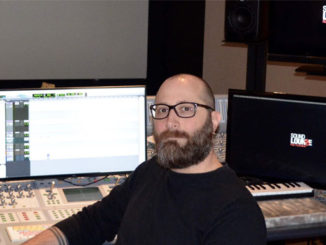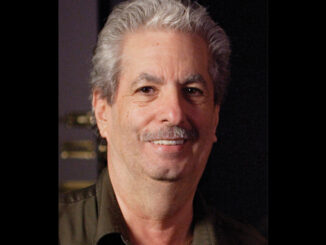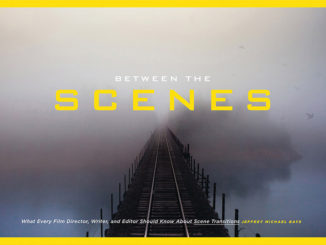by Garrett Gilchrist • portraits by John Clifford
It’s more about a man’s journey and struggle against conventional wisdom than it is about Baseball,” says editor Christopher Tellefsen, A.C.E. The film he’s discussing is Moneyball, which opens September 23 through Columbia Pictures, and the man is Billy Beane, portrayed by Brad Pitt. Based on Michael Lewis’ non-fiction book of the same name, it tells the story of Beane, a star high school athlete with a keen mind who played big league Baseball for five years, not particularly distinguishing himself. But as general manager of the Oakland A’s, he pioneered the use of computer analysis to put together a competitive team on a small budget.
Tellefsen previously worked with Moneyball’s director Bennett Miller on the Oscar-winning Capote. His credits include such varied films as The Village, Analyze This, Fair Game, Gummo, Kids, Metropolitan and The People vs. Larry Flynt. Editors Guild Magazine caught up with the New York-based editor while he was working on the film in LA, to discuss his latest project as well as his career.
Editors Guild Magazine: How has the early reaction been to Moneyball?
Christopher Tellefsen: At screenings, people really respond to the story, even many who have no interest in baseball whatsoever. It’s a strong human story, about taking chances against everyone else’s supposed better judgment. The preview process has been very positive for Moneyball. It’s an audience film; a serious, funny, beautiful film.
EGM: Ten years ago, Billy Beane’s strategies were considered highly unusual.
CT: The Oakland A’s didn’t have the money to build a championship team, but realized they didn’t need all-star athletes who could do it all. Beane found under- valued players who might have defects in some areas, but did one thing very well––it’s about getting on base and creating runs. Beane was the first to analyze players in that way. He worked with statistician Paul DePodesta [played by Jonah Hill, as Peter Brand], using sabermetrics [the analysis of baseball through statistics]. It’s his struggle against the conventional wisdom. He gave second chances to players who thought they were washed up. He understood that because he had been misunderstood as a player.
 EGM: What is it like working with director Bennett Miller?
EGM: What is it like working with director Bennett Miller?
CT: Bennett’s background is in documentary. When he gets on the set, he’s looking for that moment of reality, and won’t stop until he feels he’s got it. There’s tons of improvisation. Bennett shot about a million feet of footage. We had a great script, but most scenes were rewritten on the day to get them right. Wally Pfister shot it. Everything looked gorgeous, with a lot of interestingly complicated angles to play with. It’s not too still and it’s not too handheld. I was very happy with the footage and I’m very happy with the film.
EGM: Was his Capote a similar process?
CT: Very different. Moneyball is a large studio film; Capote was a much smaller, $7.5 million movie shot in 30 days in Winnipeg. We didn’t do previews with cards afterward. We did exactly what we wanted.
Also, while it was helpful to vibe Moneyball out with an audience, and very interesting to hear people’s responses, I don’t think previews would have helped Capote. We wouldn’t have learned anything.
On Analyze This, previews were enormously helpful. You have to have confidence in what’s funny and the audience isn’t going to prove it to you, but they’ll help you know what’s coming across. What’s really tough are emotional shifts, when you’re really looking to land a point, and make sure it’s felt. We get a lot from just sitting in the room and feeling what people are responding to––where it’s working, where it’s not.
EGM: What was it like working on Analyze This?
CT: Analyze This was a wonderful process. It was pure entertainment. That’s born from the absolutely pitch-perfect dynamic between Robert De Niro and Billy Crystal that stemmed from their relationship off-screen; Billy was always looking for approval and De Niro never gave him an ounce. There was this eagerness and this dismissiveness that was really interesting.
There was a big meeting scene near the end that just wasn’t working. It was much straighter, not nearly as crazy as it ended up being. Producer Paula Weinstein said, “You’ve got to give Billy a moment here. Re-create the set and let him just go.” What resulted was hysterically funny and made the whole movie work. Analyze This was so funny because it was unrelenting; the jokes just keep coming. People went back to see it again because they felt they’d missed stuff. We didn’t plan that. I tried to keep a very antic rhythm––like in Flirting with Disaster.
EGM: Which David O. Russell directed.
CT: That’s a film I love. David is an inspired filmmaker and Flirting is such an influential comedy. A little underestimated in its day; maybe before its time. But I see the influence of the comic structure––which, in editing, we created––in a lot of comedies that followed. David writes very personal films, much from his own raw memories. His films have an uneasiness. To take that and make it very funny is an achievement.
EGM: How did you get your start?
CT: I was obsessed with movies. In the ‘70s, you couldn’t rent a video. I went to art-house theatres and revival houses three, four times a week to see classic movies and foreign films. There’s nothing like being enveloped in a great film. I still religiously watch dailies on as large a screen as I can.
During my last year as an art major at the Cooper Union, I took an experimental film class with Bob Breer, who was inspiring. I started doing collage films. I’d shoot stuff off the television and re-edit it. I fell in love with the process. At that point, I knew what I wanted to do.

EGM: What was your first job?
CT: I got an assistant job on a terrible feature starring Jackie Mason. After letting me do a first cut, the producers disappeared, but resurfaced the next year with another film, directed by the great editor, Ralph Rosenblum. I re-edited the Mason film under Ralph’s guidance. I’d read Ralph’s book backward and forward. His work on Woody Allen films and The Producers was such seminal comedic editing. He was an enormous inspiration, and we got on quite well. Sonya Polonsky was editing Ralph’s film. She had worked on Woodstock, then assisted on Raging Bull.
Sonya introduced me and I became an apprentice for the legendary Thelma Schoonmaker on The Color of Money. I also worked on Martin Scorsese’s archive, and during that time, by sleuthing, located the missing negatives of David Lynch’s Eraserhead. It was an experience, but I knew I didn’t want to be an assistant. I edited a short film by Evan Dunsky for Apparatus, a little, non-profit film company formed by Christine Vachon and Todd Haynes. After that, I did a fun and funky performance feature called Revolution! Then I met Whit Stillman, and was soon editing Metropolitan.
EGM: You’ve worked with a lot of great directors.
CT: I try to be very discerning about what I spend my time doing. Metropolitan is still very important to me. Whit’s script was so unique and charming; a study in social anthropology set on the Upper East Side.
EGM: You did a few films with Wayne Wang, including Smoke and Blue in the Face.
CT: Smoke was a beautiful film. Maysie Hoy was the editor. After she left, Miramax was insisting on cuts. Wayne entrusted me as an additional editor to judiciously trim out ten minutes.
During the shooting, Wayne and the writer, Paul Auster, enjoyed the improvisations the actors were doing so much that they wrote Blue in the Face as a sketch piece. I was up for Kids at the time, and really wanted to work with Larry Clark. Wayne and Paul said it would be a string of long, single takes and would only take a couple weeks. But later, when I started moving things around and jump-cutting, they got really excited. Larry wanted me on Kids, so I wound up working on both films simultaneously. At one point, I was doing changes on Smoke as well. Three films at once. I had about nine assistants.
It’s funny, when I started to do bigger pictures, assistants found me puzzling because I was so used to being a one- man band. I’ve followed my own path. It’s different, and different is good.
EGM: Kids was a landmark
and very controversial picture, released with an NC-17 rating.
CT: They show Kids at certain schools now in health classes to prevent AIDS. It’s a cautionary tale, but it’s also experiential and a tad glamorous too. It was made purely independently. Miramax created a company called Shining Excalibur to put out that one film. They’d had some controversy with a film called Priest, and had just been absorbed by Disney, so Miramax couldn’t have an NC-17 film. But they didn’t force it to be an R. We were able to make it exactly the way it was intended. It was very pure, not screwed with.
EGM: The independent film scene is very different today than it was in the 1990s.
CT: That was an exciting time. The ‘90s went by so fast. I was happy to be a part of it. There were some strong voices out there. The Oscar nominations started going toward smaller pictures because they were just more interesting than what was coming out of the studios. They weren’t paint-by-numbers or made by audience response. People responded to that. They got a wide release. Today, the more daring material might be on YouTube.
EGM: Talk about your work with Milos Forman on The People vs. Larry Flynt and Man on the Moon.
CT: Milos doesn’t move the camera much, but everything is very covered. In the trial scenes in Larry Flynt, every single juror had coverage. There was about 800,000 feet of film. It was a big, challenging job; very intense. The film is a paean by Forman to the American justice system. When Larry says, “If the First Amendment will protect a scumbag like me, it will protect all of you,” that was the heart of the film and, incidentally, a vital message to us today––to preserve that.

EGM: Man on the Moon also bends reality.
CT: Milos enjoys pushing those edges and not worrying about such things. With Andy Kaufman, you’ve got a human being who didn’t live much in reality. You see Andy’s influence everywhere today. The sad thing with Larry Flynt is that there was such a backlash about sexism and pornography, but not addressing what the film was truly about. People were try- ing to crush the film for their own rea- sons. Unfortunately, it largely worked. We closed the New York Film Festival, got insanely good reviews, but the smear campaign really killed it.
GG: Tell me about Gummo, which you edited for Harmony Korine.
CT: Larry Flynt had been so intense and controlled. I approached Gummo like a projectile vomit. I just went through it. I tried not to overwork it, but I restructured a lot. There was a script, but two-thirds of it was thrown away. They shot in a grim, depressed town outside Nashville–– extremely high unemployment; maybe 40 percent of the people had done time. Harmony handed the PAs Hi-8 cameras and had them film things on the street…a cat covered in maggots…a dead dog that they threw off the roof. Amazing images that were kind of happenstance. I did it in 11 weeks, then there was a cutoff.
EGM: Quite different from a film star- ring Brad Pitt.
CT: [laughs] But Bennett and I approach a film starring Brad Pitt as if it’s a documentary about some guy you never knew. That’s important to Brad too. He’s been incredibly dedicated. He just gets it. He really wanted to play this role, and it’s a great performance. People said, “Oh, you can’t make a movie out of that book!” Even Michael Lewis himself, the writer, didn’t know exactly what the film should be. He saw it recently and was thrilled. He’s so happy with it.
EGM: What was it like editing The Village for M. Night Shyamalan?
CT: Such an interesting film. A very con- temporary, post-9/11 story about the insane lengths you’ll go to protect your children. Creating monsters to keep people scared. Those yellow, red and orange terror alerts. That’s what it was about and somehow that never seemed to penetrate anyone! It’ll be appreciated in the future, I think. Night storyboards everything to the Nth degree. He’s very rigid with his shooting and very specific. There was very little footage. It was a challenge shaping it. When scenes are mostly done in masters with nowhere to go, you have to figure out the ins and the outs with a mathematical certainty in order to not paint yourself into a corner.
EGM: Fair Game tackled the very of- the-moment political scandal of the Valerie Plame scandal.
CT: This was very personal to Doug Liman, the director. Everyone on the film was so passionate, wanting the point to come across: the injustice, the cover-up and how truly awful it was. Our angle was to show how it affected a relationship. Naomi Watts and Sean Penn sold it 300 percent. They’re just wonderful.
“It’s easy to simply make something work. It’s hard to get it to that other level where it really affects you.”
EGM: How do you describe your editorial process?
CT: It’s interpretive and reactive. I look at the dailies very carefully, then make what I call a knee-jerk cut, just responding to the material, and not over-thinking it. The director and I can sit down and get an overview. Then the sculpting, shifting and restructuring happens.
EGM: You want the film to hit the audience the same way, like a lightning bolt.
CT: Exactly. It’s about reaction. We make films to affect people. Every time I look at a film I’m working on, I try to preserve that initial feeling; keep it fresh––like I’ve never seen it before. Sometimes I think, “Ugh that scene is overworked.” But other times, a scene I’ve killed myself over ends up being a standout because it is so well thought-out. It’s always surprising. It has to feel simple, but it’s not simple to create.
Bennett and I both love looking for the odd gesture, the oddly repeated line. Something just slightly off that gives it a sense of reality. I like getting the rhythms right, searching out the cadence of truth. In Capote, Philip Seymour Hoffman was doing so much physical stuff that he’d tremble. His lip would flutter, his eye would wander. That sort of thing was gold. In Moneyball, Brad’s eye is twitch- ing, or his expression looks like the season has worn him out entirely. I search for these physical aspects that accumulate to tell a story. Dede Allen called it “coal mining.”
EGM: Otherwise, you’re cutting the obvious version.
CT: It’s easy to simply make something work. It’s hard to get it to that other level where it really affects you.






